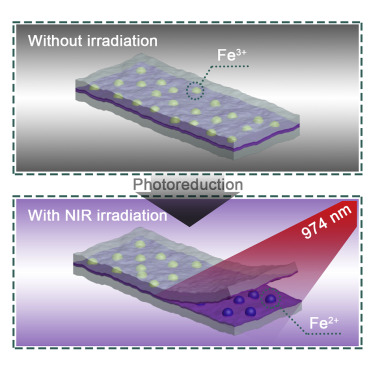iScience ( IF 5.8 ) Pub Date : 2020-01-11 , DOI: 10.1016/j.isci.2020.100832 Mingyue Jiang 1 , Xue Liu 1 , Zhijun Chen 1 , Jian Li 1 , Shouxin Liu 1 , Shujun Li 1

|
Achieving efficient and biocompatible detachment between adhered wet materials (i.e., tissues and hydrogels) is a major challenge. Recently, photodetachable topological adhesion has shown great promise as a strategy for conquering this hurdle. However, this photodetachment was triggered by UV light with poor biocompatibility and penetration capacity. This study describes near-infrared (NIR) light-detached topological adhesion based on polyacrylic acid coated upconverting nanoparticles ([email protected]) and a photodetachable adhesive (termed Cell-Fe). Cell-Fe is a coordinated topological adhesive consisting of carboxymethylcellulose and Fe3+ that can be photodecomposed by UV light. To prepare a substrate for NIR-detached topological adhesion, [email protected] and Cell-Fe were mixed and brushed on the surface of the model adherent. The [email protected] can harvest NIR light and convert it into UV light, triggering the decomposition of the Cell-Fe and inducing the detachment. This NIR-detached topological adhesion is also feasible in deep tissue because of the ability of NIR light to penetrate tissue.
中文翻译:

通过上转换纳米粒子实现近红外粘接。
在粘附的湿材料(即组织和水凝胶)之间实现有效且生物相容的分离是一项重大挑战。近来,可光分离的拓扑粘附已经显示出作为克服这一障碍的策略的巨大希望。但是,这种光分离是由生物相容性和渗透能力差的紫外线触发的。这项研究描述了基于聚丙烯酸涂层的上转换纳米粒子([受电子邮件保护])和可光剥离粘合剂(称为Cell-Fe)的近红外(NIR)光剥离拓扑粘合。Cell-Fe是由羧甲基纤维素和Fe 3+组成的配位拓扑胶可以被紫外线光分解。为了制备用于分离NIR的拓扑粘附的基质,将[电子邮件保护]和Cell-Fe混合并刷在模型粘附体的表面上。受[电子邮件保护的]可以收集NIR光并将其转换为UV光,从而触发Cell-Fe的分解并引起脱离。由于近红外光穿透组织的能力,这种与近红外光谱分离的拓扑粘附在深层组织中也是可行的。



























 京公网安备 11010802027423号
京公网安备 11010802027423号